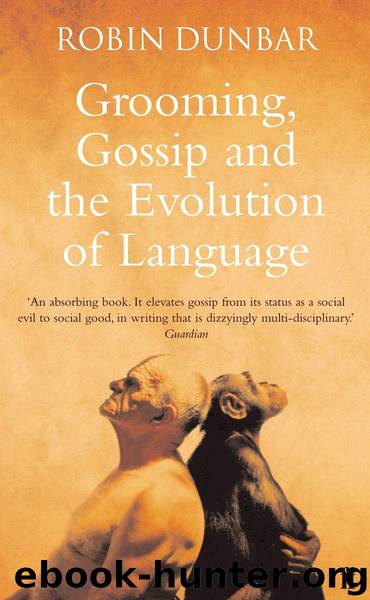Grooming, Gossip and the Evolution of Language by Robin Dunbar

Author:Robin Dunbar
Language: eng
Format: mobi, epub
ISBN: 9780571265183
Publisher: Faber & Faber
Published: 2011-04-06T22:00:00+00:00
Testing the Hypothesis
If language evolved to facilitate the bonding of larger groups, then we should be able to show that it has design features that would achieve this. One is that conversation groups should be proportionately larger than conventional primate grooming cliques. Another is that conversation time should be predominantly devoted to the exchange of social information. In one sense at least, the latter would be a strong test of the hypothesis, because conventional wisdom has it that language exists to facilitate the exchange of information about the world in which we live – the view that we spend our time discussing the bison down by the lake.
In order to test these predictions, my students and I sampled conversation groups in various locations. Our only prerequisite was that the people concerned should be engaged in relaxed social interaction
with friends. We wanted to avoid formal situations, where the rules of conversation are often deliberately constrained. We sampled conversations in university cafeterias, at public receptions, during fire practices (while everyone was waiting for the all-clear to go back inside the evacuated building), in trains and in bars.
The first thing we found was that conversation groups are not infinitely large. In fact, there appears to be a decisive upper limit of about four on the number of individuals who can be involved in a conversation. The next time you are at a social gathering such as a reception or a party, take a look around you. You will see that conversations begin when two or three individuals start talking to each other. In due course, other individuals will join them one by one. As each does so, the speaker and the listeners try to involve them in the conversation, directing comments to them or simply moving to allow them to join the circle. However, when the group reaches five people, things start to go wrong. The group becomes unstable: despite all efforts (and groups often do try), it proves impossible to retain the attention of all the members. Instead, two individuals will start talking to each other, setting up a rival conversation within the group. Eventually, they will break away to start a new conversation group. This is a remarkably robust feature of human conversational behaviour, and I guarantee that you will see it if you spend a few minutes watching people in social settings.
Since there is only ever one speaker at a time (aside from momentary overlaps or attempts to butt in), this limit of four on the size of conversation groups means there are three listeners. That is a particularly interesting number, because it is three times the number of parties involved in a conventional grooming interaction – which always consist of just one groomer and one ‘groomee’. The largest mean group size observed in any primate species is about 55, in chimpanzees (remember that these are mean group sizes, not the largest groups ever observed in a given species). This may be an extraordinary coincidence, but the predicted (and observed) size of modern human groups, 150 individuals, is almost exactly three times larger.
Download
Grooming, Gossip and the Evolution of Language by Robin Dunbar.epub
This site does not store any files on its server. We only index and link to content provided by other sites. Please contact the content providers to delete copyright contents if any and email us, we'll remove relevant links or contents immediately.
| Anthropology | Archaeology |
| Philosophy | Politics & Government |
| Social Sciences | Sociology |
| Women's Studies |
Born to Run: by Christopher McDougall(7047)
The Leavers by Lisa Ko(6896)
iGen by Jean M. Twenge(5352)
Sapiens by Yuval Noah Harari(5281)
The Kite Runner by Khaled Hosseini(5061)
Spare by Prince Harry The Duke of Sussex(5054)
Machine Learning at Scale with H2O by Gregory Keys | David Whiting(4115)
Bullshit Jobs by David Graeber(4068)
Never by Ken Follett(3767)
Goodbye Paradise(3714)
Livewired by David Eagleman(3663)
Fairy Tale by Stephen King(3197)
A Dictionary of Sociology by Unknown(2998)
Harry Potter 4 - Harry Potter and The Goblet of Fire by J.K.Rowling(2974)
The Social Psychology of Inequality by Unknown(2922)
The Club by A.L. Brooks(2852)
Will by Will Smith(2772)
0041152001443424520 .pdf by Unknown(2771)
People of the Earth: An Introduction to World Prehistory by Dr. Brian Fagan & Nadia Durrani(2690)
